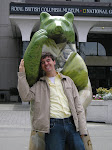Sorry for the lack of new music these two weeks. I've been attending music conferences and working on a piece I can't post online. Expect a post soon about technology and open source materials in the music theory classroom. In the meantime, enjoy this review!
CUA Symphony Orchestra
Wednesday, March 18, 2009
Hartke Theatre, The Catholic University of America
The CUA Symphony Orchestra gave an excellent concert on Wednesday of this week. A hesitant yet mostly satisfying Lincoln Portrait opened the evening. The narration was delivered in a simple and effective manner by CUA President Father David O'Connell, under the steady and able direction of David Searle. The more animated sections came off with suitable vigor and grandeur. As is the danger with many of Copland's rustic, “Americana”-flavored works, though, some of the sparse moments suffered from a notable lack of precision and confidence.
During excerpts from Mendelssohn's Midsummer Night's Dream, the CUA Women's Chorus displayed notable improvement in tone, blend and diction from their competent fall performance. Despite some obvious tuning issues in the beginning of the staccato second selection, the orchestra played well. Solo vocalists Diana Bryan and Ashley Alden certainly held their own as individual singers and also blended well together, particularly on various passages in thirds. Bryan displayed an especially sweet tone and great vocal control. Unfortunately, a dim spot on stage somewhat obscured Alden.
Thanks to the stellar soloist and a solid orchestral performance, Mendelssohn's Violin Concerto in e minor was the most moving work on the concert. The octave-doubling on rapid arpeggiated figures was just one example of Ji-Young Kim's beautiful marriage of passionate playing with technical facility. The beginning of the first lengthy cadenza came off as a bit raw when touching on the open strings. A flashy stream of trills, arpeggios and quick runs more than made up for this minor flaw, though.
The unbroken transition to the Andante movement was handled gracefully by Mr. Searle and the bassoonist. (Kim's soaring vibrato and fluid melodic figurations have inspired this writer, for one, to explore the sound of the movement on the theremin!) The undulating harmonic background figures on the soloist's lower strings, while impressive to the eye, seemed too cumbersome to have any real musical impact. These likely should have been confined to the orchestra, as they were throughout much of the movement. The third and final movement was a bit of a letdown, yet this was through no fault of the performers. From the bland opening motive to the hokey closing harmonies, this section strongly implied a fiery fourth movement that, unfortunately, never transpired.
The premiere of CUA composer Joseph Santo's Malachey Elyon was well executed and generally very well received. Dense yet subdued chromatic (microtonal?) cluster chords in the strings – vaguely reminiscent of Penderecki's Threnody – showed great promise. These sonorities were imitated effectively in the piano in its high and low registers, accompanied by temple blocks (a favorite color combination of many modern composers). Were the choir larger, this technique may have been explored even further to great effect.
Soloist Alexander Wolniak delivered his chant-like lines in a simple and lyrical tone that was perhaps the most effective aspect of the work. His diction was convincing and precise. Aside from some rather stilted whispering, the chorus also did a fine job adding to the texture. While rife with emotional weight, the recorded speeches lacked the cadential qualities and inherent musicality needed for a successful joining of music and spoken word. The form may have benefited from a more liberal cutting of the texts as well as musical material that more closely traced the emotional arc of the words. Overall, though, the work was as very well-crafted, well-rehearsed, and eminently fit for the occasion.
Led in no small part by a talented guest harpist, the CUA Orchestra closed its nearly two-and-one-half hour concert with Debussy's La Mer. Serving as the end of a genre-spanning concert, this work was satisfying and very well-prepared by Mr. Searle. The rich variety of textures kept the audience's attention, as did the technical acrobatics of a brave and oft-divided cello section. The lush harmonies also provided a nice contrast to the gestural and sectional nature Santo's piece that preceded it. This was certainly among the finest all-around concerts presented by the CUA Orchestra in recent memory, particularly in regard to the high quality of the performers as well as the interesting and well-rounded program selection.
Sunday, March 22, 2009
Review: CUA Symphony Orchestra
Subscribe to:
Post Comments (Atom)


No comments:
Post a Comment